mobile View, to the German Version tap the flag


- Hashemite Kingdom of Jordan
- monarchy with parliamentary tendencies
- own name: Al-Mamlakah Al-Urdunniyah Al Hashimiyah
• Flags
• Historical Flags
• Meaning/Origin of the Flag
• Coat of Arms
• Meaning/Origin of the Coat of Arms
• Aircraft Roundel
• Map
• Numbers and Facts
• History
• Origin of the Country's Name
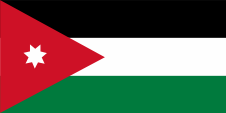
National flag,
ratio = 1:2,
Source, by: Flaggen und Wappen





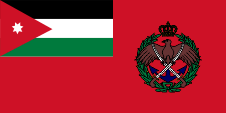
War flag (Flag of the armed forces),
ratio = 1:2,
Source, by: Flags of the World



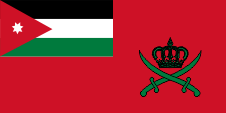
Flag of the army,
ratio = 1:2,
Source, by: Flags of the World



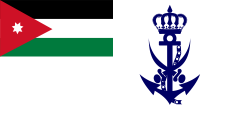
Naval flag,
ratio = 1:2,
Source, by: Flags of the World



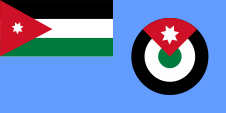
Flag of the air force,
ratio = 1:2,
Source, by: Flags of the World



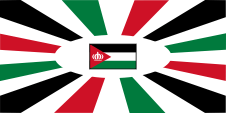
Flag of the King,
ratio = 1:2,
Source, by: Flags of the World




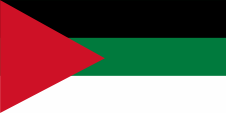
1917,
Flag of the Arabian Revolt,
Source, by:
Die Welt der Flaggen



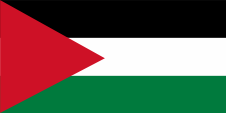
1921–1928,
National flag,
ratio = 1:2,
Source, by:
Die Welt der Flaggen




The colour quartet of four, green, white, black and red is a special Arabian colours symbol, the Panarabian colours. The (Pan)Arabian colours were officially introduced by the Sheriff Hussein of Mekka – of the lineage of the Hashemides – as colours of the Arabian Movement during the First World War at the secession of the Kingdom of Hedjas from the Ottoman Empire. The flag of Hedjas served as pattern. The colours have the following meaning: Red is the colour of Omar, the second calif; white stands for the Omajiades, a calif-dynasty, which goes back to the fifth calif Moawija I.; green stands for the Fatimides, a ismailitic-shiit calif-dynasty, which goes back to the fourth calif Ali; and black stands for the Abbasides, a calif-dynasty, which goes back to the calif Abbas I. Red is also the colour of the Hashemides, an Arabian sovereign-dynasty, which probably goes back to Hashim ibn Abd al-Manaf, the grandfather of Mohammed. Green is in addition generally the colour of Islam, and does not refer only to the Arabian countries. The in 1921 introduced flag of Jordan resembles the flag of the Arabian revolt against the Turks, however in changed arrangement of the colours, namely horizontal black, white and green. On 16th of April in 1928 was added a seven-jagged white star, symbolizing the seven basic suras of the islamic believe, which initiate the Koran. The seven jags stand even for the seven provinces of "Great Syria", which claim the Hashemites. Great Syria involves the Hedjas and the today's states Jordan, Syria and Iraq. The Arab Legion was founded in today's Jordan in 1916. It united the anti-Ottoman Arab insurgents under a red flag, with the flag of the Arab Rebellion in the upper corner and two crossed swords below a crown in the flying end. The flag of today's Jordanian army goes back to this flag. The colors of the flag of Jordan are specified as follows, besides black and white: Green = RGB 0|122|61, which would correspond to Pantone 356 and Red = RGB 206|17|38, which would correspond to Pantone 186.
Source:
Die Welt der Flaggen,
Flaggen und Coat of arms of the Welt,
Flaggen-Atlas Erde,
Wikipedia (EN)


Coat of arms of Jordan,
Source, by:
Corel Draw 4

The coat of arms was designed in the year 1921 by Emir Adallah and showed initially the Eagle of Saladin, an in the Arabian world widespread symbol, above a blue globe, which growes above a round shield. It symbolizes the expansion of the Islam in the world. Palm fronds and wheat ears symbolize Jordanian products. The Arabian inscription in the golden ribbon is a invocation to God. In the year 1987 the Eagle of Saladin was substitute by an hawk.
Source:
Flaggen und Coat of arms of the Welt


Aircraft Roundel,
Source, by: Wikipedia (EN)

Location:
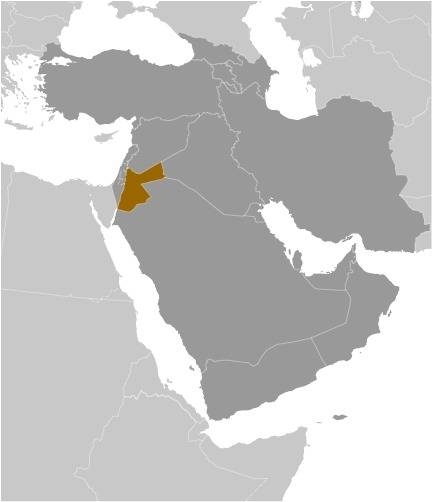
Source: CIA World Factbook
Map of the country:
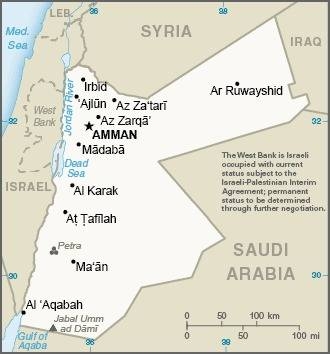
Source: CIA World Factbook

Area: 34.495 square miles
Inhabitants: 10.200.000 (2020), thereof 98% Arabs (thereof 50% Palestinians), 1% Circassians, 1% Druze, Roma, Turkmen
Religions: 93 % Muslim, 5 % Christians
Density of Population: 296 inh./sq.mi.
Capital: Amman (Rabbath Ammon, Philadelphia), ca. 4.044.000 inh. (2015)
official Language: Arabic
Currency: 1 Jordan Dinar (JOD, JD) = 100 Piaster
Time Zone: GMT + 2 h
Source:
Wikipedia (D)

11.–7. cent. B.C. · to the Babylonic-Assyrian Empire
7. cent. B.C. · to the Egyptian Empire of the Ptolemaios
106 · as a part of the Province of Arabia to the Roman Empire
395 · with the partition of the Roman Empire to Byzantium (Eastern Roman Empire)
602 · conquest by the Sassanides (Persia)
634 · conquest by the Arabs, beginning islamization
12./13. cent. · partially to the Kingdom of Yerusalem
1516 · conquest by the Ottoman Empire
1914–1918 · First World War, the Ottoman Empire has to leave Transjordan
1920 · Transjordan comes as mandate of the League of Nations together with Palestina under administration of
United Kingdom
1922 · Transjordan gets separated from Palestina as an Emirate
1925 · Transjordan purchases the Aqaba Harbor from Saudi-Arabia
1945 · member of the Arabian League
1946 · independence as Hashemite Kingdom of Transjordan
1948/1949 · war against Israel, Transjordan occupies parts of the Arabian Palestina (Western Jordan Land)
23rd of April in 1950 · the land is officially named Hashemite Kingdom of Jordan
1952 · King Talal gets dismissed, throne successor is his son Hussain II.
1957 · the king unseats the left government with the help of armed forces
1958 · confederation with Iraq into the Arabian Federation
1958 · coup d'état in Iraq, the federation gets dissolved
1967 · Israel occupies in the Six-Days-War the Western Jordan Land, thousands of Palestinian refugees flood to Jordan
1970/1971 · civil war between Jordanians und Palestinians
1974 · Jordan gives up the West Bank with reservations, but recognizes the PLO as the sole representative of the Palestinians
1988 · Jordan disclaims officially the Western Jordan Land
1994 · peace treaty between Jordan and Israel
1999 · death of King Hussain II., throne successor is his son Abdullah
Source: Wikipedia (D)

The name of the country goes back to the River Jordan. This land was named "Transjordan" after the collapse of the Ottoman Empire in the First World War, the "Land beyond the Jordan". In the year 1950 followed the renaming in "Jordan".
Source: Handbuch der geographischen Namen


![]()





























